French stage and film actress Madeleine Sologne (1912-1995) was a popular star in the late 1930s and 1940s. She became the symbol for a generation when she appeared as a modern Isolde in Jean Cocteau’s L'Éternel Retour/The Eternal Return (1941). She and her film partner Jean Marais became the ideal couple of the European cinema of the 1940s. Girls did their hair in the long, blond Sologne fashion. But in 1948 the actress retired.
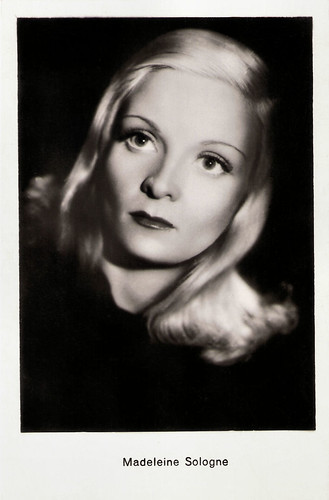
Czech postcard by Ceskoslevenske filmové nakladatelstvi, Praha, no. 15.

French postcard by Editions P.I., Paris, no. 45. Photo: Roger Carlet.

French postcard by Editions P.I., Paris, no. 120 (?). Photo: Roger Carlet.
Madeleine Sologne was born as Madeleine Vouillon in the village La Ferte-Imbault in the region Sologne, France in 1912. She was the daughter of a poor tailor and she left her village after the death of her father.
At 16, she became an apprentice of Caroline Reboux, a famous hat designer in Paris. Next she opened her own millinery shop. In 1936, she married cinematographer Alain Douarinou. She also became the model of painter Mojzesz Kisling, who encouraged her to take acting lessons, with Julien Bertheau and Jacques Baumer.
Her first theatrical experience was in the play in Boccace, conte 19/Boccaccio tale 19 by Julien Luchaire. She made her film debut with a small role in the collective Popular Front propaganda film, La vie est à nous/Life is ours (Jean Renoir, Jean Boyer a.o., 1936). She continued to play small parts such as in Les gens du voyage/People Who Travel (Jacques Feyder, 1938).
In 1939, she rose to star status in Le monde tremblera/The world will tremble (Richard Pottier, 1939) next to Claude Dauphin and Erich von Stroheim. The screenplay, based on an obscure book, was written by Henri-Georges Clouzot, and tells about a machine that can tell you how many years, days, hours and minutes you have left to live.
She then appeared as the partner of Fernandel in the comedy Raphaël le tatoué/Raphael tattooed (Christian-Jaque, 1939), and her brown hair suited her well when she played a gypsy in Le Danube bleu/The Blue Danube (Emil E. Reinert, Alfred Rode, 1939) at the side of José Noguéro.

French postcard, no. 74. Photo: Roger Carlet.
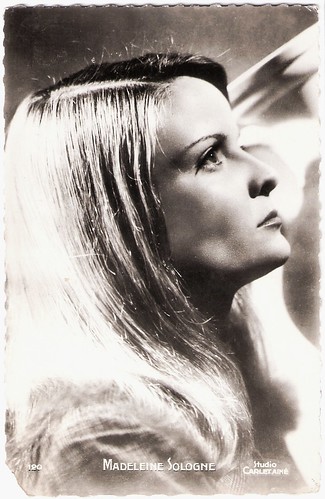
French postcard by Editions P.I., Paris, no. 120. Photo: Studio Carlet Ainé.

French postcard by Editions Publications Cinématographiques, no. 238.

French postcard by Editions Chantal, Rueil (S.O.), no. 62. Photo: Ind.ie Ciném.que.

French postcard by Editions Chantal, Ruell-Malmaison, no. 79. Photo: A. Paulvé.
The German invasion in 1940 slowed down French film production, but the following year Madeleine Sologne starred in Fièvres/Fever (Jean Delannoy, 1941). In this film she played the wife of Tino Rossi, consumed by jealousy and dying of grief at her husband's infidelity. Another success was Le loup des Malveneur/The Wolf of Malveneur (Guillaume Radot, 1943) with Pierre Renoir.
Then the highlight of Sologne’s career came with the powerful romantic tragedy L'Éternel Retour/The Eternal Return (Jean Delannoy, 1943). The story, written by Jean Cocteau, is a modern update of the Tristan and Isolde legend. As the modern Tristan and Isolde, newcomer Jean Marais and Sologne are a stunningly handsome couple.
Sologne as blond Natalie had dyed her brown hair blond for the occasion, with a long falling lock à la Veronica Lake. The two lovers, symbolising the youth living under the yoke of the Nazi occupation, became mythical in the eyes of a generation.
In her obituary of Sologne in the British newspaper The Independent, Ginette Vincendeau writes: “The film is typical of the strong escapist trend in the cinema of the time which took its roots in history or legend - as did other films, such as Marcel Carné's Les Visiteurs du soir (1942) and Les Enfants du paradis (1943-45) - but paradoxically Sologne's success in it was due to her modern appearance.”
Both Sologne's smooth blond hairstyle and Marais' patterned jersey sweater, designed by the couturier Marcel Rochas (as were Sologne's clothes), were widely copied. Young girls did their hair ‘in the Madeleine Sologne fashion’.
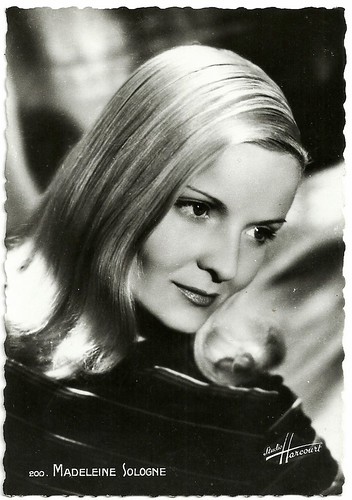
French postcard by Editions Greff, Paris, no. 200. Photo: Studio Harcourt.
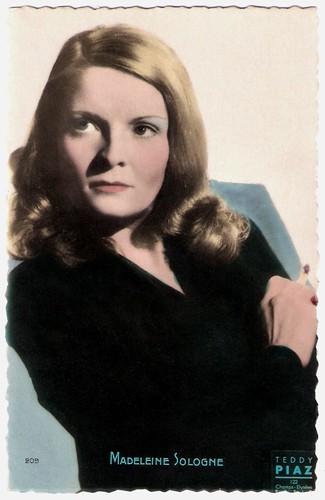
French postcard by Editions O.P., Paris, no. 209. Photo: Teddy Piaz.
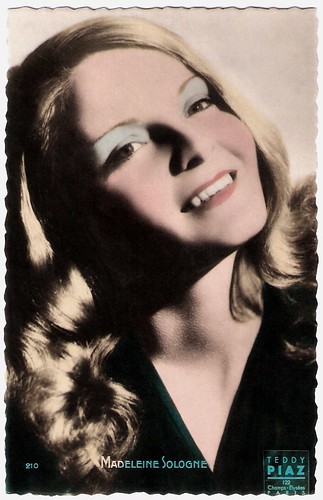
French postcard by Editions O.P., Paris, no. 210. Photo: Teddy Piaz.

French postcard by Editions P.I., Paris, no. 120. Photo: Cinéma Pathé.
Her powerful mythical character in L'Éternel Retour/The Eternal Return (1943) and its popularity became paradoxically Madeleine Sologne’s swansong. After the war she returned in the lesser-known but fascinating La Foire aux chimères/Devil and the Angel (Pierre Chenal, 1946) co-starring Erich von Stroheim.
In a melodramatic reprise of Charles Chaplin's City Lights story of 1931, Sologne plays a beautiful blind woman whose disfigured benefactor (Von Stroheim) goes mad and kills himself when she recovers her sight and leaves him.
Neither this nor her following films ever attained the popular or critical success of L'Eternel retour. After some minor roles, the actress retired in 1948.
During the 1950s she only appeared on stage, such as in La forêt pétrifiée/The Petrified Forest by Robert Emmet Sherwood, then in Aux quatre coins/The four corners by Jean Marsan and L'homme traqué/The hunted man by Francis Carco. She returned incidentally to the cinema, a last time for a small role in the crime drama Le Temps des loups/The Time of the Wolves (Sergio Gobbi, 1969) starring Robert Hossein.
She divorced Alain Douarinou and then married production manager Leopold Schlosberg. She regularly appeared on TV. After her second husband’s death in 1976, she returned to the region of her birth, Sologne. In 1995, Madeleine Sologne died in a nursing home in Vierzon, France. She was 82.
Scene from La Foire aux chimères/Devil and the Angel (Pierre Chenal, 1946) with Erich von Stroheim (no subtitles). Source: Richard Francomac (YouTube).
Scene from Fièvres/Fever (Jean Delannoy, 1941) with Tino Rossi. (No subtitles). Source: Jm Veynois (YouTube).
Another scene from Fièvres/Fever (Jean Delannoy, 1941) with Tino Rossi. (No subtitles). Source: Jm Veynois (YouTube).
Scene from L'Éternel Retour/The Eternal Return (1943) (No subtitles). Source: jean claude Deroudilhe (YouTube).
Sources: Caroline Hanotte (CinéArtistes), Ginette Vincendeau (The Independent), Lenin Imports, Wikipedia (French) and IMDb.

Czech postcard by Ceskoslevenske filmové nakladatelstvi, Praha, no. 15.

French postcard by Editions P.I., Paris, no. 45. Photo: Roger Carlet.

French postcard by Editions P.I., Paris, no. 120 (?). Photo: Roger Carlet.
The world Will Tremble
Madeleine Sologne was born as Madeleine Vouillon in the village La Ferte-Imbault in the region Sologne, France in 1912. She was the daughter of a poor tailor and she left her village after the death of her father.
At 16, she became an apprentice of Caroline Reboux, a famous hat designer in Paris. Next she opened her own millinery shop. In 1936, she married cinematographer Alain Douarinou. She also became the model of painter Mojzesz Kisling, who encouraged her to take acting lessons, with Julien Bertheau and Jacques Baumer.
Her first theatrical experience was in the play in Boccace, conte 19/Boccaccio tale 19 by Julien Luchaire. She made her film debut with a small role in the collective Popular Front propaganda film, La vie est à nous/Life is ours (Jean Renoir, Jean Boyer a.o., 1936). She continued to play small parts such as in Les gens du voyage/People Who Travel (Jacques Feyder, 1938).
In 1939, she rose to star status in Le monde tremblera/The world will tremble (Richard Pottier, 1939) next to Claude Dauphin and Erich von Stroheim. The screenplay, based on an obscure book, was written by Henri-Georges Clouzot, and tells about a machine that can tell you how many years, days, hours and minutes you have left to live.
She then appeared as the partner of Fernandel in the comedy Raphaël le tatoué/Raphael tattooed (Christian-Jaque, 1939), and her brown hair suited her well when she played a gypsy in Le Danube bleu/The Blue Danube (Emil E. Reinert, Alfred Rode, 1939) at the side of José Noguéro.

French postcard, no. 74. Photo: Roger Carlet.

French postcard by Editions P.I., Paris, no. 120. Photo: Studio Carlet Ainé.

French postcard by Editions Publications Cinématographiques, no. 238.

French postcard by Editions Chantal, Rueil (S.O.), no. 62. Photo: Ind.ie Ciném.que.

French postcard by Editions Chantal, Ruell-Malmaison, no. 79. Photo: A. Paulvé.
The Eternal Return
The German invasion in 1940 slowed down French film production, but the following year Madeleine Sologne starred in Fièvres/Fever (Jean Delannoy, 1941). In this film she played the wife of Tino Rossi, consumed by jealousy and dying of grief at her husband's infidelity. Another success was Le loup des Malveneur/The Wolf of Malveneur (Guillaume Radot, 1943) with Pierre Renoir.
Then the highlight of Sologne’s career came with the powerful romantic tragedy L'Éternel Retour/The Eternal Return (Jean Delannoy, 1943). The story, written by Jean Cocteau, is a modern update of the Tristan and Isolde legend. As the modern Tristan and Isolde, newcomer Jean Marais and Sologne are a stunningly handsome couple.
Sologne as blond Natalie had dyed her brown hair blond for the occasion, with a long falling lock à la Veronica Lake. The two lovers, symbolising the youth living under the yoke of the Nazi occupation, became mythical in the eyes of a generation.
In her obituary of Sologne in the British newspaper The Independent, Ginette Vincendeau writes: “The film is typical of the strong escapist trend in the cinema of the time which took its roots in history or legend - as did other films, such as Marcel Carné's Les Visiteurs du soir (1942) and Les Enfants du paradis (1943-45) - but paradoxically Sologne's success in it was due to her modern appearance.”
Both Sologne's smooth blond hairstyle and Marais' patterned jersey sweater, designed by the couturier Marcel Rochas (as were Sologne's clothes), were widely copied. Young girls did their hair ‘in the Madeleine Sologne fashion’.

French postcard by Editions Greff, Paris, no. 200. Photo: Studio Harcourt.

French postcard by Editions O.P., Paris, no. 209. Photo: Teddy Piaz.

French postcard by Editions O.P., Paris, no. 210. Photo: Teddy Piaz.

French postcard by Editions P.I., Paris, no. 120. Photo: Cinéma Pathé.
Swan Song
Her powerful mythical character in L'Éternel Retour/The Eternal Return (1943) and its popularity became paradoxically Madeleine Sologne’s swansong. After the war she returned in the lesser-known but fascinating La Foire aux chimères/Devil and the Angel (Pierre Chenal, 1946) co-starring Erich von Stroheim.
In a melodramatic reprise of Charles Chaplin's City Lights story of 1931, Sologne plays a beautiful blind woman whose disfigured benefactor (Von Stroheim) goes mad and kills himself when she recovers her sight and leaves him.
Neither this nor her following films ever attained the popular or critical success of L'Eternel retour. After some minor roles, the actress retired in 1948.
During the 1950s she only appeared on stage, such as in La forêt pétrifiée/The Petrified Forest by Robert Emmet Sherwood, then in Aux quatre coins/The four corners by Jean Marsan and L'homme traqué/The hunted man by Francis Carco. She returned incidentally to the cinema, a last time for a small role in the crime drama Le Temps des loups/The Time of the Wolves (Sergio Gobbi, 1969) starring Robert Hossein.
She divorced Alain Douarinou and then married production manager Leopold Schlosberg. She regularly appeared on TV. After her second husband’s death in 1976, she returned to the region of her birth, Sologne. In 1995, Madeleine Sologne died in a nursing home in Vierzon, France. She was 82.
Scene from La Foire aux chimères/Devil and the Angel (Pierre Chenal, 1946) with Erich von Stroheim (no subtitles). Source: Richard Francomac (YouTube).
Scene from Fièvres/Fever (Jean Delannoy, 1941) with Tino Rossi. (No subtitles). Source: Jm Veynois (YouTube).
Another scene from Fièvres/Fever (Jean Delannoy, 1941) with Tino Rossi. (No subtitles). Source: Jm Veynois (YouTube).
Scene from L'Éternel Retour/The Eternal Return (1943) (No subtitles). Source: jean claude Deroudilhe (YouTube).
Sources: Caroline Hanotte (CinéArtistes), Ginette Vincendeau (The Independent), Lenin Imports, Wikipedia (French) and IMDb.
No comments:
Post a Comment